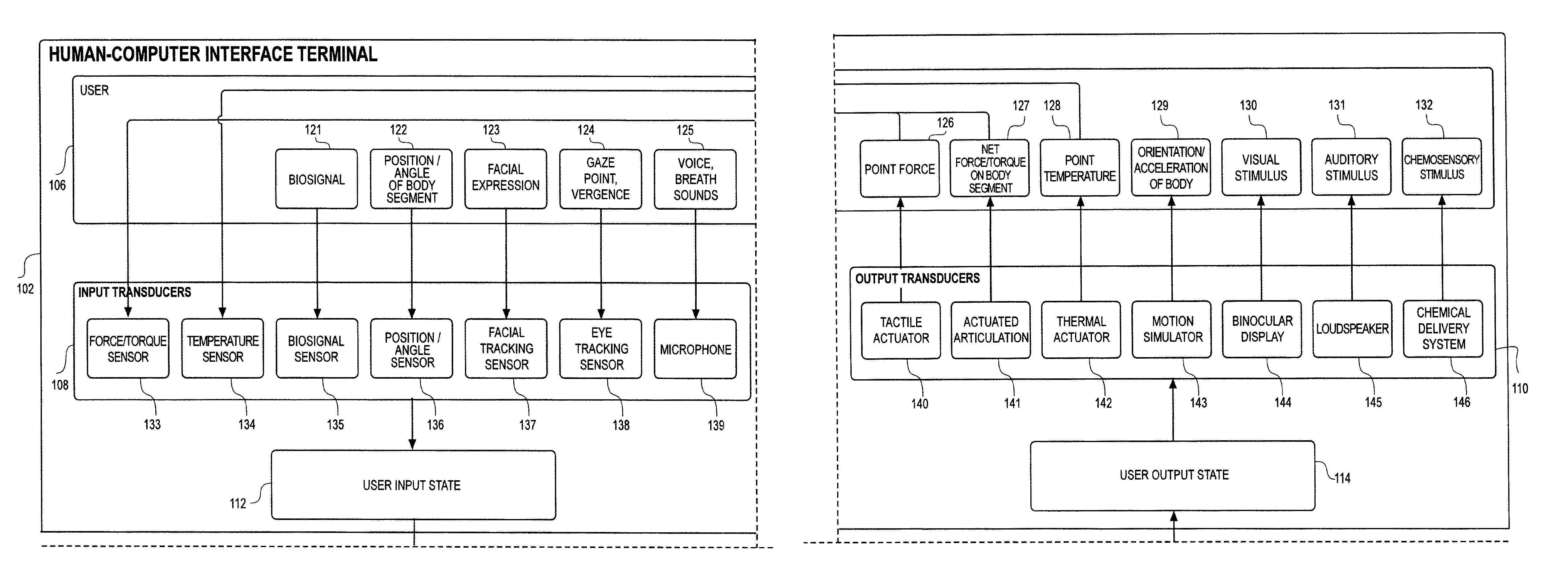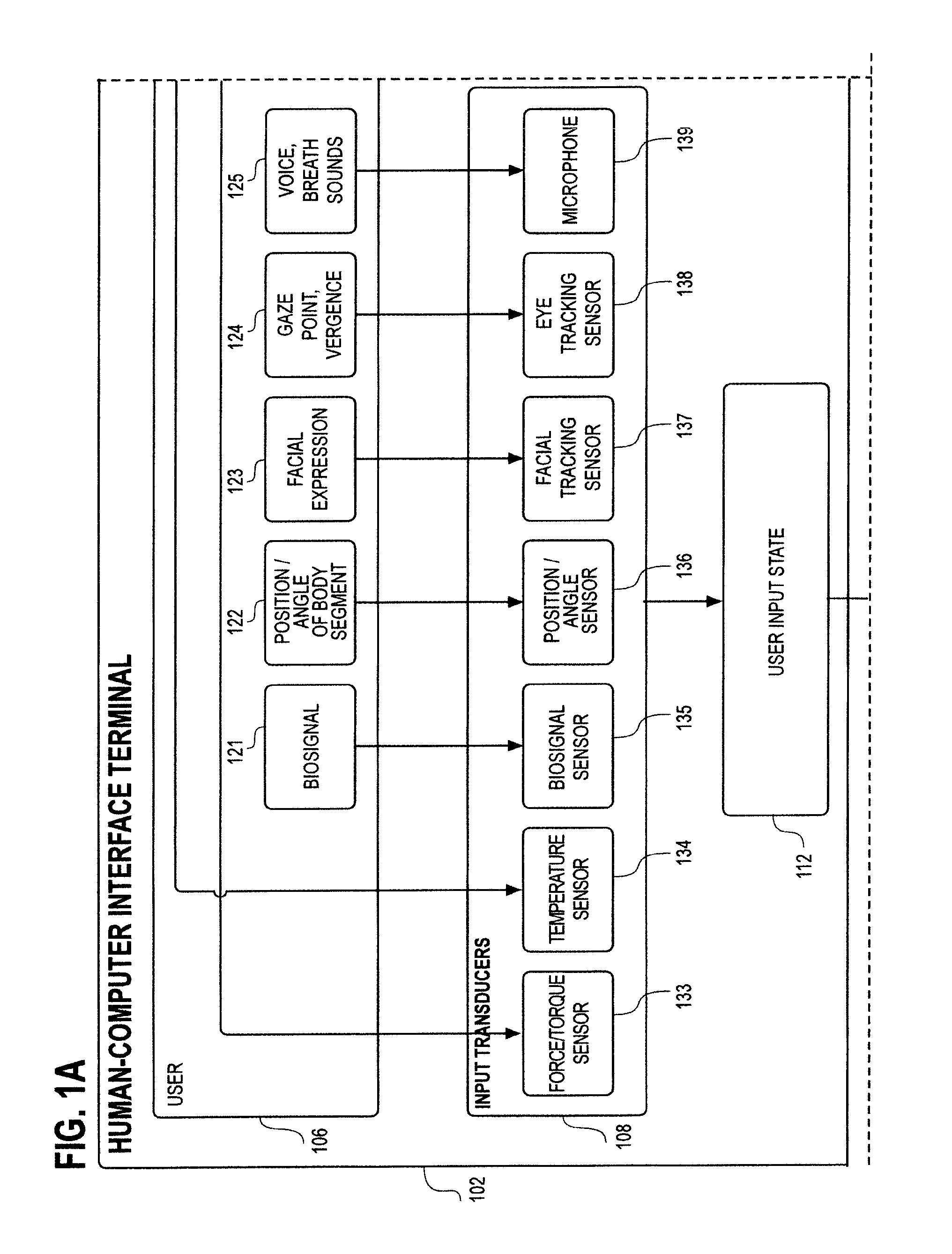Whole-body human-computer interface
a human-computer interface and whole-body technology, applied in the field of virtual reality human-computer interfaces, can solve the problems of no known human-computer interface device yet to come close to achieving, limited general applicability, and little change in the commercial landscape of human-computer interfaces
- Summary
- Abstract
- Description
- Claims
- Application Information
AI Technical Summary
Benefits of technology
Problems solved by technology
Method used
Image
Examples
first embodiment
[0129]The proximal boundary 450 of opisthenar structural member 412 is preferably delimited approximately by the radial styloid process of the wearer's wrist. Distal boundary 452 is preferably delimited approximately by the proximal edge of the metacarpophalangeal joints of the wearer's second through fifth metacarpals. Medial and lateral boundaries of opisthenar structural member 412 are preferably delimited approximately by the outside edges of the wearer's second and fifth metacarpal respectively. In one embodiment, an opisthenar structural member 412 comprises a length adjustment mechanism (not shown), preferably located near wrist joint 419a. In a first embodiment, a hand segment 204a / b (FIG. 2) of an exoskeleton comprises an opisthenar structural member 412 and a means of securing the opisthenar structural member 412 to the wearer's hand (not shown in FIGS. 4A-4B). Said means can, for example, comprise a strap, band, glove, brace, or similar element.
second embodiment
[0130]Referring now to FIG. 9, a hand segment 204a / b is shown. Opisthenar structural member 412 is coupled to thumb proximal phalangeal structural member 920 via thumb metacarpophalangeal joint 939. Thumb metacarpophalangeal joint 939 preferably comprises two pin-type revolute articulations 942 and 944, whose compound motion emulates flexion / extension and abduction / adduction of the metacarpophalangeal joint of the wearer's thumb. Articulation 934 is coupled to articulation 942 via an arc-shaped structural member 919. Arc-shaped structural member 919 is preferred to be shaped so as to project as little as possible from the hand of the wearer without limiting the range of motion of the wearer or the exoskeleton.
[0131]Thumb proximal phalangeal structural member 920 is coupled to thumb intermediate phalangeal structural member 922 via thumb proximal interphalangeal joint 935. Thumb proximal interphalangeal joint 935 preferably comprises one or more pin-type articulations 936, 937 having...
third embodiment
[0134]In a hand segment 204a / b (FIG. 2), a device is provided to be held in the wearer's hand. Said device is preferably coupled to opisthenar structural member 412 (FIGS. 4A-4B). In one variation, said device comprises a controller, such as a game controller. This controller preferably comprises at least one input transducer, such as a button, which can be used to provide input to a computer-mediated environment process 116 (FIG. 1). In another variation, said hand-held device comprises a “prop,” such as a gun, sword, or medical instrument that represents a corresponding article in a computer-mediated environment process 116 (FIG. 1). This prop likewise optionally comprises one or more input transducers, such as a trigger, which can be used to provide input to a computer-mediated environment process 116 (FIG. 1). In an additional variation, said hand-held device comprises a handle or other stiff projection that can be enclosed by the hand of the wearer.
PUM
 Login to View More
Login to View More Abstract
Description
Claims
Application Information
 Login to View More
Login to View More - R&D
- Intellectual Property
- Life Sciences
- Materials
- Tech Scout
- Unparalleled Data Quality
- Higher Quality Content
- 60% Fewer Hallucinations
Browse by: Latest US Patents, China's latest patents, Technical Efficacy Thesaurus, Application Domain, Technology Topic, Popular Technical Reports.
© 2025 PatSnap. All rights reserved.Legal|Privacy policy|Modern Slavery Act Transparency Statement|Sitemap|About US| Contact US: help@patsnap.com



